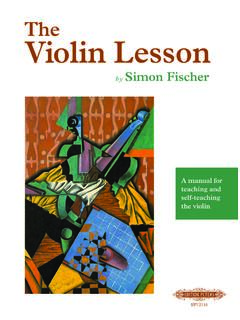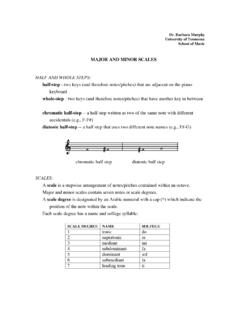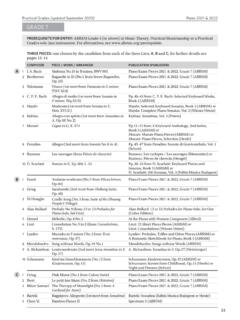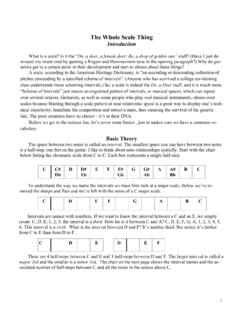Transcription of Scales and scale studies for the violin - Edition Peters
1 Scalesby Simon FischerNo. 71908 Scales and scale studies for the violinHow to tune each note of the scale1 4 One-octave scales2 6 One-octave arpeggio sequence3 18 Chromatic scales4 22 Warm-up exercise: fourth-finger extensions5 25 Two-octave Scales and arpeggios6 26 Two-octave broken thirds and fourths7 40 Three-octave Scales : structuring intonation8 52 Tone-semitone patterns9 64 Scales : exercise for overlapping the first and 10 fourth fingers 68 One-octave Scales in all positions without shifting11 70 The turning-point at the top of the scale12 82 Three-octave Scales : exercise for timing shifts13 83 harmonic minor scale : exercise for augmented 2nd, 14 fourth to first finger 89 Warm-up exercise: smooth bowing15 89 Exercise to develop fast fingers 16 90 Warm-up exercise: moving fingers independently 17 of the hand 90 Placing fingers in blocks18 91 One-octave arpeggio sequence in all positions 19 without shifting 96 Starting at the top20 101 Three-octave arpeggios: exercise for timing shifts21 102 ContentsPart 1 Notes, page 2 Scales and arpeggios in low positions without shiftingPart 2 Notes, page 48 Three-octave Scales and arpeggios.
2 Preparatory practiceIntroduction vHow to use Scales viiPart 4 Notes, page 142 Scales and arpeggios on one stringPart 3 Notes, page 120 Three-octave Scales , arpeggios and chromatic scalesPart 5 Notes, page 194 Four-octave Scales and arpeggiosThree-octave diminished sevenths22 106 Three-octave dominant sevenths23 109 Arpeggios: shifting exercise24 112 Practice method: trilling the shift25 113 Practice method: uniform intonation in arpeggios26 113 Arpeggios: placing fingers in blocks27 114 Chromatic Scales : exercise for 321 or 123 fingering28 118 Rhythm, accent, bowing and dynamic patterns29 122 Speeding up with the metronome30 124 Three-octave Scales , arpeggios and chromatic scales31 129 Single-finger Scales and arpeggios32 144 Two-finger scales33 152 One-octave scales34 156 One-octave arpeggios35 168 Broken thirds on the E string36 180 Arpeggios: strengthening the top octave37 182 Two-octave Scales and arpeggios38 183 Speeding up with the metronome39 195 Four-octave Scales and arpeggios40 196v IntroductionBuilding the scale in stagesAn important and original feature of this book is that Scales are built up in stages, with notes added in a particular harmonic order.
3 The word scale comes from the Latin word scala , which means ladder . But whereas when we climb a ladder we need only focus on one rung at a time, a scale should be built and structured so that each note is felt according to its position in the key, and its relationship with the rest of the Catalan cellist Pablo Casals, widely regarded as one of the most influential musicians of the 20th century, taught Scales in this way, as did the American violinist Dorothy DeLay, one of the foremost violin teachers at the end of the 20th century. She devised the same approach as Casals, without knowing that he had thought along the same lines. All I was trying to do, she said, was to find a way of getting my students to play their Scales in tune! We are taught that the major scale is made up of the series tone tone semitone tone tone tone semitone.
4 But this obscures the true symmetry of the scale , which is revealed if you think of it as two groups of four notes (tetrachords), each comprising tone tone semitone, which are joined by a tone. minor Scales are similarly made up of two tetrachords and can also be thought of as two equal halves, even though the pattern of tones and semitones are not the same in each and DeLay structured the scale as follows. Begin with the notes of the perfect intervals (the first and fourth notes in each half of the scale ): I, IV; V, VIII (in A major: A, D; E, A), all the way up the scale and down again. Then add the leading note (G+ in A major), feeling what Casals called its gravitational attraction upward to the tonic and the third (C+), feeling it as a leading note to the fourth. Of course, the third is not a leading note like the seventh, but for the purposes of tuning the scale it can be treated as , add the second and the sixth (in A major: B and F+).
5 These should be tuned according to how high you pitch the third and the seventh which, to some degree, is a matter of taste. If you choose to play the thirds and sevenths higher, the seconds and sixths have to be higher too, otherwise you will have adjacent whole tones which are sequence taught by Casals and DeLay is musically satisfying in both major and minor keys, but in the major it is particularly effective because you can measure the third and the seventh in relation to the fourth and the octave. It is not quite so satisfactory for helping to measure the flattened thirds and flattened sevenths in the minor scale . So, in some sections I have added a further stage before stage 2: after playing I, IV; V, VIII, play I, III; V, VII, the first and third notes of each half. In other words, first play perfect fourths starting on the tonic and on the fifth; and then play major or minor thirds starting on the tonic and the I first began to add this new stage it was intended to be used only in minor Scales .
6 Soon it became obvious, because of the new light it casts on the third and seventh, that it is also very helpful in the major scale out the stages in each scaleThe basic outline of the Carl Flesch scale System first appeared in Volume 1 of Flesch s Art of violin Playing (1924). It was written out only in C major in the belief that players would naturally apply the same patterns to the other keys as well. However, some years later vi Flesch realized that because the system was shown only in C major, most of his students practised Scales only in that key and rarely, if ever, in any other. So he wrote out the scale and arpeggio sequences in all the keys, added bowing and rhythm patterns, and Das Skalensystem came into , while I saw Dorothy DeLay teach how to tune the Scales in individual lessons, in master classes and in her technique classes at the Aspen Music Festival, I only ever saw her demonstrate it in A major.
7 Having shown how to do it, she expected students to apply the same logic to all the other keys. I do not know how many of her students did, but I have always suspected that few of mine do so without needing constant this reason, I have followed Carl Flesch s example and, until the final few sections of Scales , written out the stages of building the scale into each key. It seems an obvious, desirable and long overdue solution to have the Scales written out in this form so that you can simply read them off the finger linesAnother original feature of Scales is the indication of where and for how long to hold fingers down. Some of these fingers ( the first finger) you would hold down in the normal course of playing to give stability to the hand; others are for the purposes of beneficial exaggeration so that afterwards, playing naturally without holding them down, everything feels much easier and more secure than before.
8 These can be adapted to suit the individual hand, with any which feel unnatural or awkward simply ignored. Equally, in some instances you may wish to add extra lines, or to hold fingers down for longer than marked. The habit of holding fingers down, with all the measuring between fingers that then takes place, is one of the foundations of a secure left preparationWhile we usually blame the bow when the tone of a note is not clean, many impure sounds are caused not by the bow but by the fingers not being ready on the natural, musical playing, the fingers prepare themselves and stop the string an instant before the bow moves. Just in time is usually the right moment for the finger to be ready on the string. But in many sections of Scales , the important fingers to prepare are shown as stemless, diamond-headed notes: place these fingers extra early, again using beneficial exaggeration.
9 Play slowly and prepare the fingers very deliberately: prepare then play. Afterwards, when you play normally, your fingers will again prepare themselves instinctively but with a new reliability. Often, the prepared fingers should be exactly in tune without needing adjustment before sounding them. But just as often especially when preparing fingers a semitone apart if you were to play the prepared fingers without first adjusting them, they would probably not be exactly in play semitones in tune, the fingers often need to be squeezed closer together than they are when placed side-by-side on the string. It all depends on the width of your fingertips and how high up the fingerboard you are. In those cases where it is impossible to prepare fingers in tune, still begin to get ready early, as marked by the diamond-headed notes, but the fingers will not find their true place on the string until the instant before the note is is a scale like when it is played well?
10 The three basic building blocks of music are pitch, sound and rhythm. When a scale or arpeggio is played at the highest standard it is entirely even in all three. The pitch is even the same letter-names in the different octaves are in tune with each other, with a consistent logic behind the tuning of each note. The sound is even undisturbed by changes of string, bow, position or finger. The rhythm is even again undisturbed by changes of string, bow, position or does not mean that the scale is played purely mechanically. Each note has its own musical character due to its place in the scale (which becomes clear when you build the scale in stages). A well-played scale is not musically empty, but full of inner tensions. And in performance it is usually desirable to crescendo to the top of the scale or arpeggio, with a sense of arrival there, unless there are particular reasons to shape it evenness of pitch, sound and rhythm, and playing musically, the last element to achieve is effortlessness.






